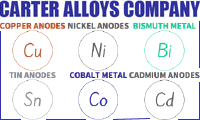
Curated with aloha by
Ted Mooney, P.E. RET

The authoritative public forum
for Metal Finishing 1989-2025

-----
Copper electroforming: deposition only happens in HCD area
June 27, 2011
Our company has to realise a process of electroforming copper deposition.
Currently we use a bath with an acid electrolyte composition: (CuSO4 220 gr/lt) + (H2SO4 50-70 gr/lt), 1 gr/lt Polyethylene glycol (PEG), and sodium chloride 0,07 g/lt.
We use phosphorized copper anodes.
We need to deposit copper thickness on a mechanical component with dimensions 280 X 280 mmts with a copper thickness deposition of about 6 mm, then we will have to deposit copper on a mechanical component with dimensions 550 x 800 mmts.
Currently the bath works at 2-4 A/dm2 generated by a DC power supply stabilized, constant current, with a thickness deposit of about 0.03 mm/hour but the problem is that deposit takes place almost exclusively on the edges and outer perimeter causing abnormal increases exponentially and does not allow the deposit in the central areas.
The use of a pulse DC power supply could help?
Many thanks for your help.
Best Regards.
Buyer - Rome, ITALY
June 29, 2011
Hi Alferdo,
Periodic Pulse Reverse (PPR) plating shall improve thickness distribution. Typical parameter setting is:
Forward CD: 2-4 asd
Reverse CD: 3-15 asd
Forward Plating Time: 20 ms
Reverse Plating Time: 1 ms
Anode to Cathode ratio: 1:1 to 2:1
Anode to Cathode distance: 20-30 cm
Alternatively, you may use anode shield to block exposure of plating part edges to anode to minimize deposition rate on high CD region.
Regards,
David

David Shiu
- Singapore
Hi,
David's response should help, but I think the part about anode shields need to be strongly emphasized. They are an essential part of much electroforming. Good luck.
Regards,

Ted Mooney, P.E.
Striving to live Aloha
finishing.com - Pine Beach, New Jersey
June 29, 2011
Hi David and Ted, many thanks for your reply.
We would try to improve electroforming with anode shield.
Do you have any suggestion to propose?
Regards.
Alfredo de Roberto
- Rome, Italy
June 30, 2011
Hi, Alfredo.
A shield is simply a piece of rigid plastic sheet, perhaps 1/8" thick PVC or polypropylene, of any given size and shape, that you place between the anodes and the cathode so that the current cannot take the shortest route from the anodes to the edges of the cathode. Normally you would put it parallel to the anodes.
For a simplest case, envision that your electroform were a 500 cm dia. disc. Then you might try a ring of plastic that was 600 cm in outer diameter and 400 cm in inside diameter. The shape of the shield is based on trial & error and experience, or electrochemical modelling software.
Regards,

Ted Mooney, P.E.
Striving to live Aloha
finishing.com - Pine Beach, New Jersey
June 30, 2011
adv.: Supplier of Copper Anodes, Nickel Anodes, Bismuth Metal, & Other Metal Products for Industry & The Arts

Q, A, or Comment on THIS thread -or- Start a NEW Thread